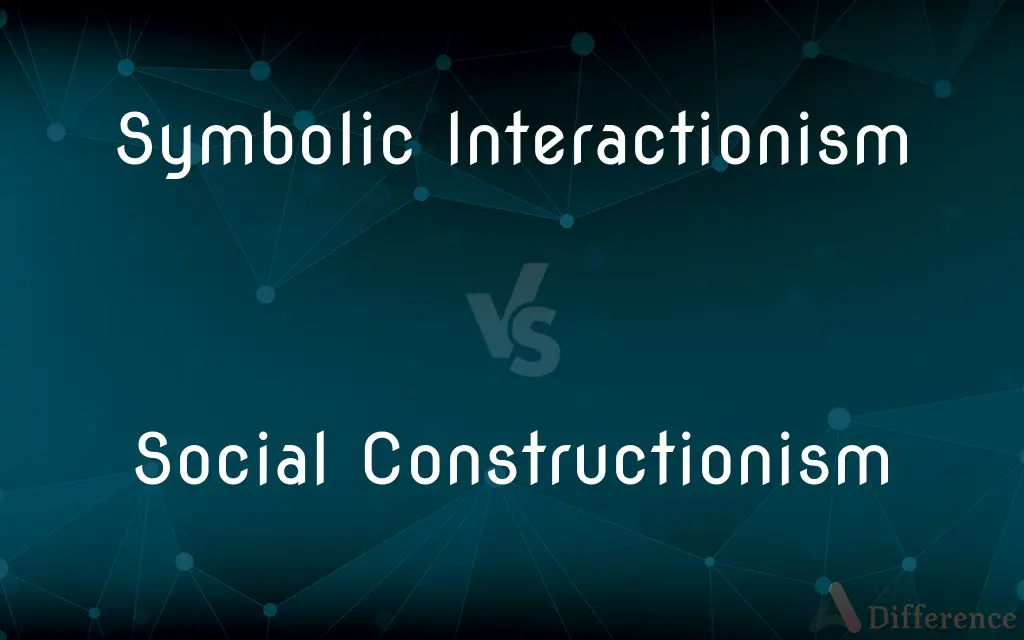Symbolic Interactionism vs. Social Constructionism — What's the Difference?
By Tayyaba Rehman — Published on January 25, 2024
Symbolic Interactionism focuses on individual and small group interactions, forming society through shared meanings. Social Constructionism sees reality as constructed by social processes, shaping our understanding of the world.

Difference Between Symbolic Interactionism and Social Constructionism
Table of Contents
ADVERTISEMENT
Key Differences
Symbolic Interactionism is a sociological perspective centering on how individuals interact through symbols like language, creating societal norms and meanings. This theory posits that people act based on the meanings things have for them, developed through interaction. Social Constructionism, on the other hand, emphasizes the ways in which social phenomena are created, institutionalized, and made into tradition by humans. It argues that reality is not inherent but socially constructed.
In Symbolic Interactionism, the focus is on the subjective aspects of social life, rather than objective, macro-structural aspects. It examines how individuals interpret and give meaning to their world through interactions. Social Constructionism looks at how societal institutions, cultural norms, and beliefs create the concept of reality, implying that things don’t exist independently outside our perception of them.
Symbolic Interactionism suggests that identity is formed through interactions with others and the social world. This theory is concerned with the ways individuals perceive and define themselves as a result of social interactions. Social Constructionism explores how various phenomena or concepts are constructed through social practices, implying that these phenomena might not exist outside of these practices.
With Symbolic Interactionism, the emphasis is on micro-scale social interaction and understanding how individuals navigate and give meaning to their social world. It is often used to understand everyday behavior and interactions. In contrast, Social Constructionism provides a macro view, exploring how larger cultural and societal forces shape perceptions and understandings of reality.
Symbolic Interactionism considers change as a result of interaction between individuals, focusing on the process of meaning-making. Social Constructionism looks at change in society as a result of established systems and cultural practices, focusing on how these systems construct our understanding of the world and societal norms.
ADVERTISEMENT
Comparison Chart
Focus
Individual and small group interactions
Social processes and institutions
Perspective
Micro-level (individuals and their interactions)
Macro-level (cultural and societal norms)
Concept of Reality
Reality is negotiated through interaction
Reality is shaped by social and cultural norms
View on Society
Society is continually constructed through individual interactions
Society is an objective reality created by collective agreement
Change Mechanism
Change happens through altered interactions and meanings
Change occurs through shifts in social practices and beliefs
Compare with Definitions
Symbolic Interactionism
Symbolic Interactionism is a theory that human interactions create symbolic meanings.
Greeting someone with a handshake symbolizes respect in many cultures.
Social Constructionism
Social Constructionism posits that knowledge and reality are created through social interactions and contexts.
Money is valued because society agrees on its worth.
Symbolic Interactionism
It emphasizes subjective meanings and the importance of human agency in interaction.
Choosing to dress formally for an interview to convey professionalism.
Social Constructionism
Social Constructionism suggests that social concepts are not inherent, but developed by society.
The concept of gender roles varies significantly across different societies.
Symbolic Interactionism
Symbolic Interactionism considers how self-identity and society are constructed through interactions.
Teenagers adopt fashion trends to fit into peer groups, shaping their identity.
Social Constructionism
It argues that what we perceive as reality is shaped by social processes and cultural norms.
Different cultures have varying definitions and perceptions of beauty.
Symbolic Interactionism
Symbolic Interactionism suggests individuals interpret symbols and act based on their meanings.
A student raising their hand in class is understood as a request to speak.
Social Constructionism
It emphasizes the collective creation and influence of societal structures on perception.
Educational systems shape our understanding of intelligence and success.
Symbolic Interactionism
It views society as composed of symbols that people use to establish meaning and communicate.
People wear wedding rings to symbolize marital commitment.
Social Constructionism
Social Constructionism views knowledge as a product of human interaction and social agreement.
Scientific theories are accepted as true because they are socially validated by the scientific community.
Common Curiosities
Can Symbolic Interactionism explain social changes?
Yes, it explains social change as a result of altered interactions and evolving meanings among individuals.
How does Symbolic Interactionism view society?
It sees society as a product of daily interactions and the meanings individuals assign to these interactions.
What is Social Constructionism?
Social Constructionism is the theory that social reality and knowledge are constructed through collective human processes.
Can Symbolic Interactionism explain individual behavior?
Yes, it can explain individual behavior as a result of the meanings derived from social interactions.
Is Social Constructionism useful in understanding cultural differences?
Yes, it helps in understanding how different cultures construct different realities and norms.
How does Social Constructionism differ from Symbolic Interactionism?
Social Constructionism focuses on macro-level societal constructs, while Symbolic Interactionism focuses on micro-level interactions.
How does Symbolic Interactionism view human communication?
It views communication as a symbolic process where people interpret and respond to each other’s actions.
What is Symbolic Interactionism?
Symbolic Interactionism is a sociological theory focusing on how individuals use symbols and interactions to create social reality.
Does Social Constructionism deny physical reality?
No, it acknowledges physical reality but emphasizes that our understanding of it is shaped by social and cultural contexts.
What role do symbols play in Symbolic Interactionism?
Symbols are crucial as they carry meanings that guide interactions and communication.
Can Social Constructionism explain societal norms?
Yes, it explains societal norms as constructs developed and maintained through social processes.
How does Symbolic Interactionism approach the concept of self?
It views the self as a social construct developed through interactions and the interpretation of symbols.
Does Symbolic Interactionism consider the impact of larger social structures?
While it focuses on micro-interactions, it acknowledges but does not emphasize larger social structures.
Does Social Constructionism apply to scientific knowledge?
Yes, it applies to all knowledge, including scientific, as socially constructed and context-dependent.
Can Social Constructionism be used to analyze political systems?
Yes, it can analyze how political systems and ideologies are socially constructed and maintained.
Share Your Discovery

Previous Comparison
Flan vs. Crème Brulee
Next Comparison
RGB vs. VGAAuthor Spotlight
Written by
Tayyaba RehmanTayyaba Rehman is a distinguished writer, currently serving as a primary contributor to askdifference.com. As a researcher in semantics and etymology, Tayyaba's passion for the complexity of languages and their distinctions has found a perfect home on the platform. Tayyaba delves into the intricacies of language, distinguishing between commonly confused words and phrases, thereby providing clarity for readers worldwide.












































